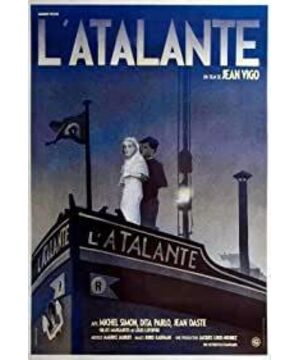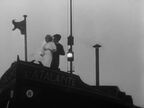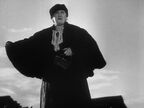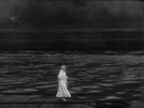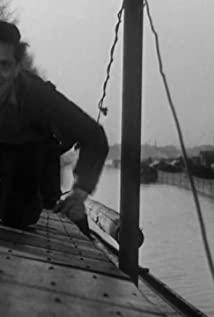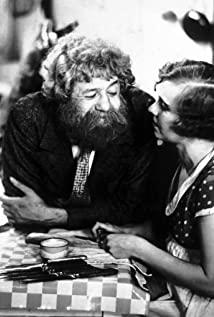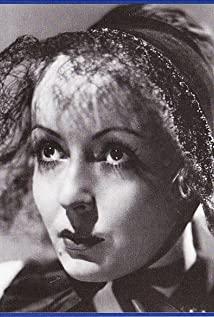"Atlanta" is Jean Vigo's only feature film and his posthumous work. It can be said that the history of the film itself is as ill-fated as the director’s short and tragic life. Before shooting this film, Jean Vigo made three short films: "À propos de Nice" (À propos de Nice, 1930) and "Taris, roi de l'eau" (Taris, roi de l'eau, 1931) are documentaries. Zéro de conduite (Zéro de conduite: Jeunes diables au collège, 1933) is a famous feature film that shows a children’s “rebellion” incident in a boarding school from a children’s perspective. The film’s depiction of rebellious youth directly affects France The "New Wave" master director François Truffaut’s "Four Hundred Strikes" (1959), and many youth films since then paid tribute to him, such as the French national treasure actress Isabel Adjani’s screen debut "Little The batting scene in The Coal Merchant (1970).
Due to the time pressure of the producer and Jean Vigo's insistence on shooting on site, "Atlanta" had to be shot in the cold midwinter season of Paris. The harsh weather and hard work directly led to the director's death. When shooting the last shot of the film (aerial shot of the barge on the river), Jean Vigo was already bedridden, and photographer Boris Kaufman could only complete the work according to the instructions he gave on the sick bed. . In February 1934, "Atlanta" finished its first cut. In April of the same year, Gaumont was very dissatisfied after seeing the sample, and the publisher did not approve it. Gaumont eventually cut the film drastically (at this time, Vigo was dying, and we will never know whether he himself agreed to this re-cut). And changed the soundtrack to a popular song (the passing barge in English), and even changed the title of the film to this song. The film was released in the fall of 1934, but the box office was still dismal. Jean Vigo died of tuberculosis on October 5 of the same year at the age of 29. The restoration history of this film is worthy of a special book, limited to time and space relations can only be briefly summarized. There are 6 more important versions of "Atlanta": The trial version of 1934 was only seen by very few people; the public version of Gaumont reduced the original film to 65 minutes; the recut version of 1940 was changed back. The original title and the soundtrack were restored, and the rest was re-cut in small increments. This is the version that Truffau, Godard and others watched when they "rediscovered" Vigo. It was also the film critics who named Vigo the greatest director in the 1950s. According to one version, Truffaut didn't even know who Jean Vigour was when he entered the cinema in 1946 (at the age of 14), but he was deeply fascinated by him after watching the movie; at the end of the 1950s, French Film Archive Curator Henri Langlois (Henri Langlois) re-collected various versions, but did not organize them into a new version for public screening; in 1990, Gaumont finally determined to restore the original version of the film, and unexpectedly in the BFI (British Film Institute) Found a copy that was considered to be the most likely original version (titled "Atlanta"), carefully produced and released a restored version after referring to other versions; in 2001, by the Vigo family, especially as a film historian The film critic’s daughter improved and restored the film. This is the final version we are seeing now. The Criterion Collection later released a Blu-ray set of four works by Jean Vigo.
In terms of form, "Atlanta" has a poetic and realistic photographic style. Jean Vigo also uses shadowy night lights in the deck scenes to create a blurred and hazy atmosphere. The intimacy of the two snuggling on the foggy deck is unforgettable. The director of photography for this film, Boris Kaufman, is the younger brother of Jiga Vertov, a representative of the Soviet "Movie Eye" school. The person in charge of "Two Angry Men" (1958). Maurice Jaubert's soundtrack is also extraordinary, with the theme song recurring and echoing at important moments many times. The style of "Atlanta" belongs to French "Poetic Realism". The film is shot in real scene, and the film production process is constantly adjusted according to various specific conditions during real shooting. The dialogue is also very colloquial, and you can hardly find the lines that are deliberately designed. However, this kind of realism did not allow the film to move towards a routine of describing and rendering the poverty and suffering of the lower working class. There was no bitterness and grievances overflowing, instead it was a true depiction of romantic love. Vigo "is not interested in the truth, but interested in experience and experimentation" (quoted and translated from the Blu-ray commentary soundtrack, the same below), he said: "The script is only a background, and I am most interested in describing the canals around Paris. , Show the daily life of the workers on the water, and work with the actors." The film has certain documentary characteristics, but it is not preaching and purely objective expression, and the content has nothing to do with "telling an absolutely true and credible story." . As Godard said, "All great fictional films tend to be documentaries, just as all great documentary literature tends to be novels." (Jean-Luc Godard, 1985: 181-182), the film is a fiction Romantic story, but it has a real touch, a poetic touch that belongs to life alone, and an open to the real (open to the real, acceptive to the real). This poetic realist French film tradition was founded by Jean Vigo, Jean Renoir, Marcel Carné and others in the 1930s, and it passed through the French New Wave (Truffaut). The sentimentality and elegance of Godard, Godard’s straightforward poetry, Rohmer’s realistic chattering, etc. all have the shadow of this tradition), which is still rooted in the creative ideas of French filmmakers to this day. In addition to live shooting and long shots, another important aspect of this tradition is to attach importance to the role of actors, encourage them to improvise, and even reach the point of shaping roles and rewriting scripts according to the actor’s body and performance characteristics (completely with this method). The reverse is Robert Bresson, who has his own style. His film requires actors to cancel all expressions and emotions, just like models, or puppets, chess pieces).
The improvisation performed by Michel simon in this film is a model for practicing this tradition. Simao once said: "There are only three directors who can truly understand me, let me play freely, and support my improvisations: Jean Renoir, Sacha Guitry, and one is Jean Vigo. "Le père Jules, played by Simao, is tall, rough, and sloppy, sometimes mad as a demon, sometimes as pure as an angel, full of mysterious and unpredictable charm. On the mist-shrouded deck, Simao wrestled with himself, which made him laugh. In the cabin full of exotic furnishings, Simong performed the unique skill of smoking a cigar with his belly button. Dita Parlo can't help but spit out his tongue (quite erotically), which is a knowing smile; after Paulo left Jean Dasté, Simao comforted the captain while talking with him. Playing chess by himself, turning the record and listening to the music, until he realized that the boy around him was playing an accordion prank, which was hilarious; when the captain was heartbroken and frustrated, Simao disembarked into the city and brought Paulo back like a godly help. People are overjoyed...Ximang, with the appreciation and support of Vigo, played this unforgettable role into a three-pointer, vividly.
The scene where Paulo was attracted to and danced with the magician boy always made me think that I was in an early comedy musical. Although I was quickly interrupted by my jealous husband, the captain and the magician's fight and chasing scenes were still Very happy and entertaining. Paulo finally ran away in anger, and suddenly realized that he was alone like a lost lamb in the urban labyrinth of Paris, and the atmosphere of the film was extremely sad. The thief walked away from her purse, but was beaten by a group. This scene was mixed, perhaps too dramatic. If there are any flaws in the film, it is because the film time after the husband and wife separated in Paris was too short. According to some information, Jean Vigo had planned to shoot more shots of the Paris scene, but unfortunately he was not able to do so for various reasons. If it can be extended by about ten minutes, the effect should be more in line with the psychological expectations of the audience.
After driving away in anger, Dust was depressed all day long, thinking of his tender wife, and the film came to an emotional climax. In the beginning of the film, Paulo once said that if you bury your head in the water, you can see the look of your sweetheart. Daxter tried several times and still to no avail. He said that he "saw it" but there was no relevant image proof. This time, Daxter finally saw in the water the lover he thought about day and night. She appeared in front of Daxter like a holy and noble angel, with flying skirts, fluttering white clothes, and the most innocent and wanton blooming on her charming face. Smile. The director used the technique of superimposing to seamlessly interweave the figures of the two and present them on the screen, showing their sincere love, which is moving.
"Atlanta" can have a place in film history, largely due to the delicate expression of subtle eroticism. Halfway through the film, the captain and his wife embraced each other ("I dreamt that you left me"). The intimacy presented to the audience in this scene surpassed many erotic clips with large-scale sex scenes. A cross-edited montage on the eve of the reunion of the two took this intimacy to a new level: the two people had different bodies, but their hearts met in a dream, and both sides were in a state of half asleep and half awake at the same time, and their desires were aroused. , Feeling full of love-parallel masturbation, this is a unique love scene. People say that it’s hard to find a sexier scene in movie history. I can’t help but think about the grit-laden morning female body shots in Hiroshi Kawara’s "Sand Girl", full of shapes, and those that seem to touch the skin. Tactile close-up. This is a specific sexual behavior that is irrelevant and different from the usual dimensions of love and physical attraction. It is delicate, gentle, touching, and charming.
With the help of the first mate, the mysterious middleman, Paulo and Duster finally met again. The two hesitated for a while before rolling to the floor and hugging. It was this brief period of hesitation that made the film banal. Super pull out in the reunion scene, into the spiritual space and time. At this moment, the action is stagnant, the gaze appears, silence replaces the movement, all thoughts are frozen in this frame, silence is better than sound. References: 1. "Atlanta" Blu-ray English commentary soundtrack, Michael Temple 2. "François Truffau", Annet Insdorf, translated by Shen Yubing, Guangxi Normal University Press, 2012 3 . "1001 Movies You Must See in Your Life (8th Edition)", edited by Steven Jay Schneider, translated by Jiang Tang et al., China Central Compilation and Translation Press, 2012 [All rights reserved, no reprinting]
For more movie recommendations, wonderful reviews and related sharing, please pay attention to the official account: Ice Red Dark Blue Movie
View more about L'Atalante reviews


